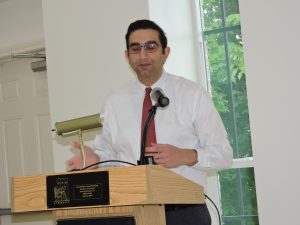On Saturday, April 21, 2018, the ZAH Library Committee presented two distinguished out-of-town speakers in two sessions before and after lunch. In the morning, Dinyar Patel traced the fascinating history of female education as it evolved in the 19th century, and how Dadabhai Naoroji served as a catalyst to promote this cause. After lunch, Cyrus Rivetna enlightened us with a talk on using architecture to complement and preserve Zoroastrianism, with specific emphasis on our Atash Kadeh under construction.


Dinyar started by noting that the status of Parsi women was no different than Hindu or Muslim women in the 1830 to 1850 time frame. Women’s lives were controlled strongly by men who severely restricted every aspect of their women’s lives. Christian missionaries were the first to start female education, but could not make much headway because the British government refused to fund any educational effort in India and the male-dominated environment made it even harder.
Gradually, men began to want educated women, recognizing that educated mothers were important to raise educated sons. From just 50 girls enrolled in the first all-girls school in 1849, the number grew to 500 by 1853. Girl students went home and taught their mothers, sisters and aunts, spreading the fire for education in them. Even so, girls were not allowed to go to school after the age of 10 or twelve. Dadabhai Naoroji quickly realized that female teachers would be needed to keep the momentum growing, and approached Parsi Philanthropists to provide funding for girls’ schools. Jamsetjee Jejeebhoy was the first to open four schools for girls, followed by Khurshedji Cama, the only member of the very conservative Cama family to give his support. Naoroji was way ahead of his time in arguing that gender equality was fundamental to India’s national interest in its goal for freedom.
Cyrus Rivetna from Chicago, is the founder and principal at Rivetna Architects, Inc. Cyrus has an incredibly impressive portfolio of commercial projects at home and abroad. But his deepest interest lies in the design of Zoroastrian Centers and places of worship. So committed is Cyrus to his passion, that he has travelled to Iran and India to study the design of Zoroastrian fire temples, and he has applied his studies to designing new structures in North America that reflect our ancient traditions.
Cyrus began his talk by emphasizing that architecture really influences the way we think and the way we live. With pictures of beautiful buildings, Cyrus showed how good architecture, properly executed, can provide the right environment for the right reason. The design of a mosque, for example, is very different from a cathedral, both inside and outside. Our Zoroastrian places of worship are more simplistic and austere in nature, in keeping with the simple tenets of our religion, but they all have certain characteristics in common.
Cyrus Rivetna is the architect of our Atash Kadeh, generously donated by Shernaz and Feroze Bhandara. He described the outside structure, as well as the inside layout of our new Atash Kadeh, which is currently under construction just across the parking lot. He walked the audience through the plan: the entrance, as well as each room in the building with its intended use. Our building will be the first of its kind in North America, allowing for the full range of religious rituals while also allowing for the natural elimination of smoke. Since the building was designed to incorporate certain salient features one expects from a Zoroastrian place of worship, Cyrus hoped that the Houston Atash Kadeh would be a prototype for other such structures in North America. The completion date is projected for the end of this year, but it was clear from all the excitement that it would be a hard waiting period.
Aban Rustomji wrapped up the session by handing out tokens of appreciation to the two speakers, and urged our staunch supporters and regular attendees to bring at least one “new” person to the next Library event.
